Sierra Nevada National Park in southern Spain is home to the highest peak in mainland Spain and actually the entire Iberian Peninsula. But Mulhacén (3479 masl) is not the only 3000-meter peak in the national park, and also not the toughest to climb.
I had climbed Mulhacén several times before from different angles and was generally well known with the Sierra Nevada’s higher altitude trails, including Veleta (3398 masl), which is the second highest peak of the national park and the third highest in the peninsula.
But there was one peak I had failed to reach not only once before but twice. The third highest peak in the Sierra Nevada and the fifth highest in mainland Spain, Alcazaba (3369 masl).
I don’t deal very well with turning around before reaching my goal. But growing up in Norway, you learn early that “it’s never too late to turn around,” and safety is more important than reaching the peak.
In fact, it’s rule number 7 of the Norwegian Mountain Code. Yes, we learned it by heart at school when I was a kid.
But just because I follow this simple rule doesn’t mean that I’m happy with it.
You could say that Alcazaba had turned into this pimple on my face that I couldn’t get rid of before I reached its top.
It was the end of summer, my rescue puppy Atlas had just turned 1 year old, and I was up for a challenge. What better way to celebrate his birthday and feed my wanderlust than going for a 4-day hike in Sierra Nevada National Park?
My partner, Mohammed, and I decided to make it a challenge to reach the 3 highest peaks, Mulhacén, Veleta, and Alcazaba.
I was so excited to finally hike to the top of Alcazaba, my fat, annoying face pimple.
Since baby Atlas was just a year old, we decided to do the challenge over four days and not three (with buffer food for an extra night. We wanted to make sure that we didn’t push his little body too hard, as this would be his first multi-day trek.
Little did we know that it was our bodies that would be pushed to their limits while the dog would have fully charged Duracell batteries every morning!
Read on for our experience and learnings!
Table of Contents
Hiking the 3 Higest Peaks in Sierra Nevada, Spain
We hiked a total of 47.5km over 4 days. We started in Hoya de la Mora, where we parked the van. Day one, we reached Pico Veleta (3398 masl), day 2 we reached Mulhacén (3479 masl), day 3 we reached Alcazaba (3,369 masl), and on the 4th day, we walked from Siete Lagunas, around Mulhacén and Veleta back to Hoya de la Mora to avoid the climbs to the peaks.
I know people do this in a day or two, but the first tip I’ll give you is to know YOUR limits and plan for the event that you might find it harder than expected, especially if you’re not used to hiking in the High Sierra.
That’s why I decided to share my reflections on the hike with all our mishaps and unexpected events.
I’m a seasoned hiker and know Sierra Nevada National Park well. But it had been a while since I headed out on a challenging hike before this one, mainly because we had a puppy during the last year, which needed to get used to our active lifestyle. I also had some health problems for a while before that, which kept me off the trails completely for a few months.
Note that I would have done things very differently if I didn’t know the area already!
I’ll share our route that I recorded on Wikiloc here.
I don’t recommend following the section of the route that we did from Siete Lagunas to Alcazaba – you’ll figure out why further ahead.
The recording ends on Alcazaba Peak, because I ran out of battery, and we had just a bit left on the power banks to charge the phone we used for vlogging.
You can see our adventure on YouTube here:
Day one – Hiking from Hoya de la Mora to Veleta
Our first lesson started already before we hit the trail. We had parked the van at Hoya de la Mora the night before to start walking early the next morning to the second-highest peak, Veleta.
This is where the ski resort is in winter, and it’s a fairly easy hike. Or so I remembered from when I had done it a few years earlier – with only a day pack.
We packed our backpacks with all the gear, a tent, food, dog food, and enough water to last to the first possible water sources that would be after the first peak. The goal was to conquer Veleta and continue to the foot of Mulhacén and sleep there the first night.

Well, that didn’t happen.
We couldn’t find Mohammed’s fleece.
We pulled out everything from the van and searched for two hours before we found it in the dirty laundry bag.
Too bad.
It had to come with us yes or yes. With expected night temperatures of 2-3 degrees there was no way around. Besides, the high sierra always has shifting temperatures, so this layer was a necessity.
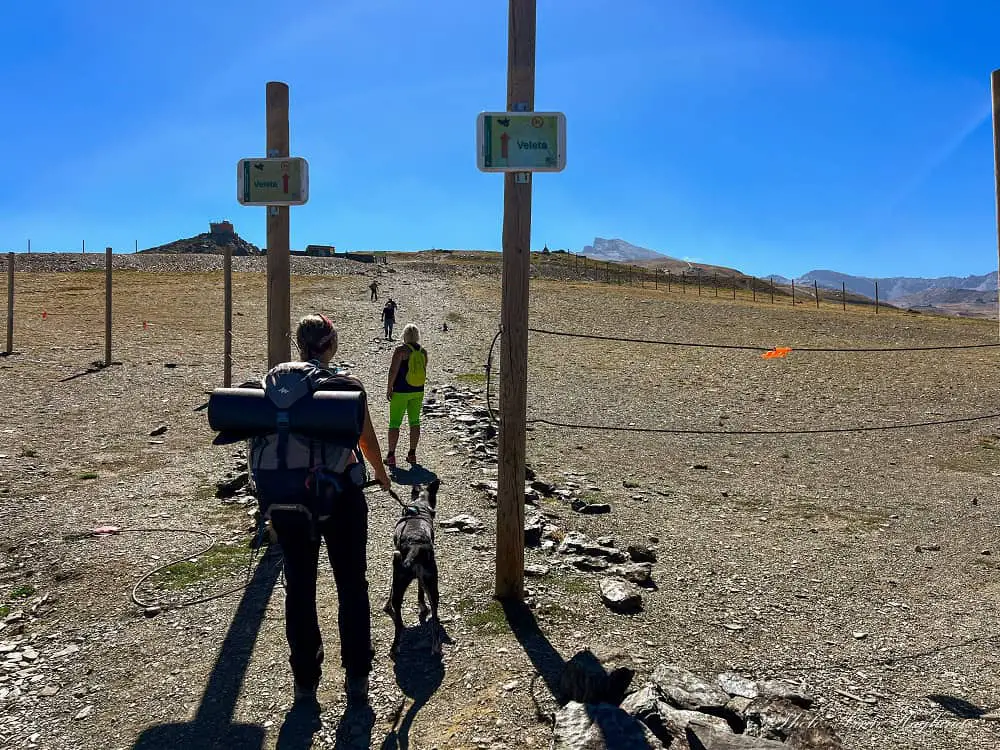
Once we found the fleece, we were ready to walk. Halfway into the day, we were way too late to reach the planned camping spot for the night, but we were still positive.
Mohammed insisted on packing his backpack a lot heavier than mine because he didn’t want me to get back pain.
We had to stop and repack after an hour because it turned out to be way too heavy for him, and he struggled to keep moving.
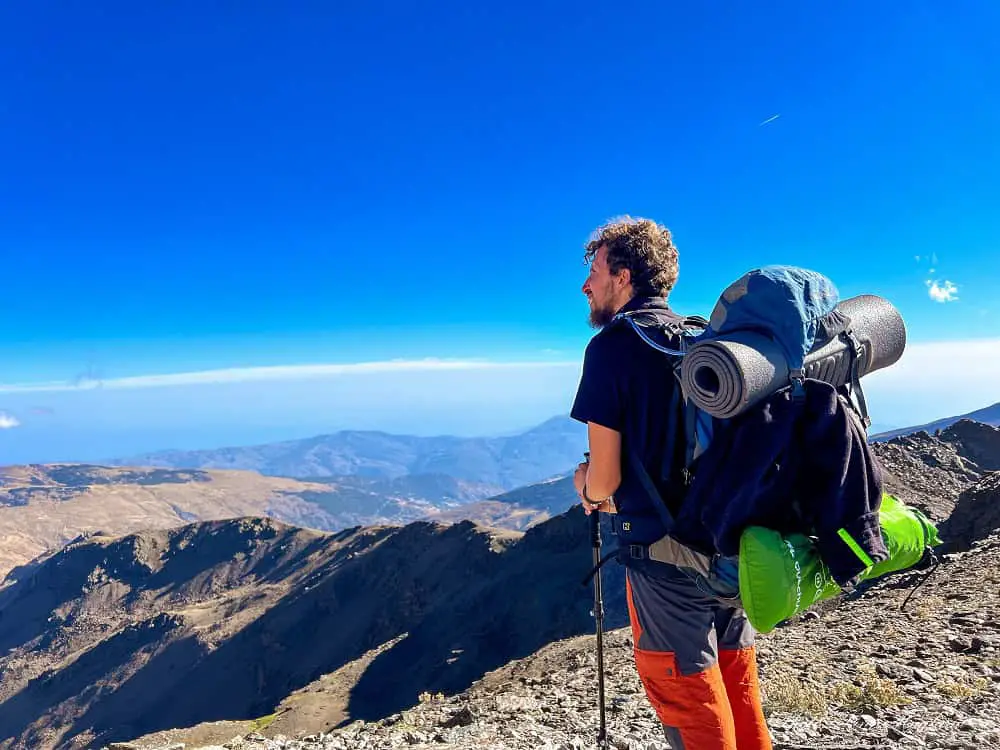
Lesson two: Make sure to even out the weight properly and don’t take on more weight than you can handle.
While I remembered the hike to Veleta to be fairly easy, it’s a completely different story with heavy backpacks.
We walked slowly, took many breaks, and walked down from the first peak just as the sun started setting.
We reached a shelter that is just below Veleta Peak, Refugio Carihuela, where we ate quickly and slept the worst night of our lives.
There were 11 French tourists who had made their way up there, and they were snoring like crazy all night. The bunk we slept on was so hard, I am sure it would feel more comfortable sleeping on the marble floor at home.

Day two – Climbing Mulhacen – A long day
After a horrible night, Mohammed woke up with a fever. I was devastated and thought we had to return to the van before the big adventure had even begun.
Remember – I was set on Alcazaba, which was due on the third day.
My poor hubby manned up and swallowed our only painkiller (needless to say, we should have brought more!), saying that no way we would turn around.
After a coffee and some porridge for breakfast, he already felt better.
We packed up and waved goodbye to the French tourists and the fox and mountain goat that had come to visit us at the shelter.
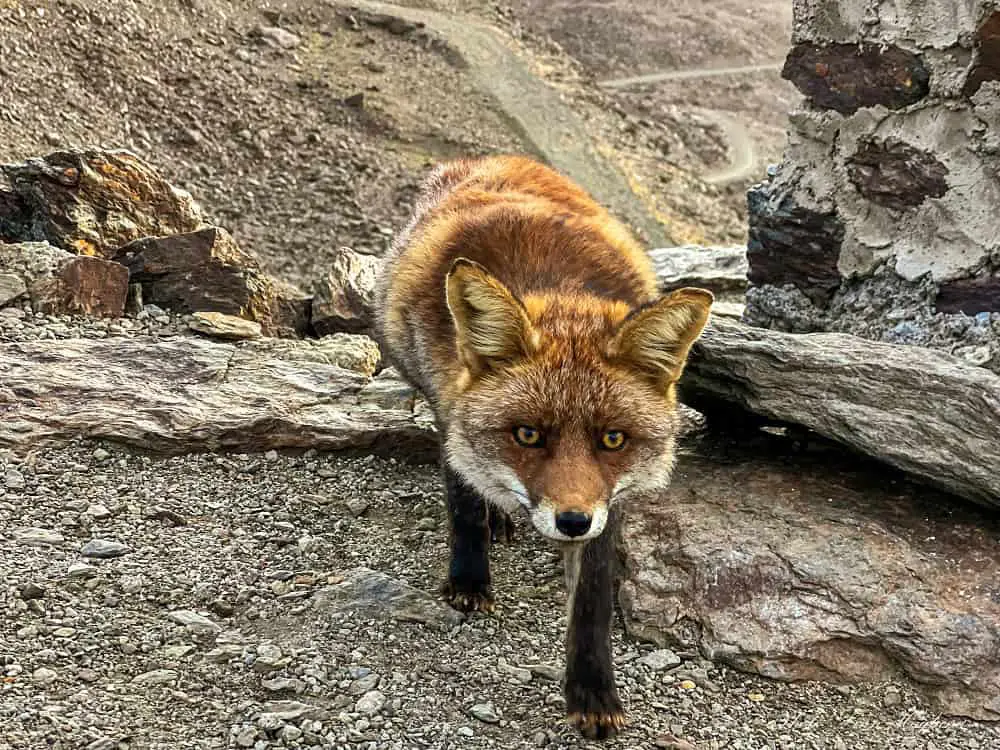
We had a long traverse to the point where we were supposed to camp the night before. But we felt happy. The sun was shining in our faces. We filtered water from mountain lakes and savored the surroundings with all of our senses.
The raw, unforgiving mountains, rockslides down the vertical cliffs, the silence, and the agility of mountain goats running elegantly down ridiculous drops made it impossible to wipe the smiles off our faces.
When we finally reached the foot of Mulhacén, we had the toughest part of the day in front of us, and we knew that we had to walk a lot further after reaching the peak if we were going to camp near a water source and have the chance to reach Alcazaba the next day.
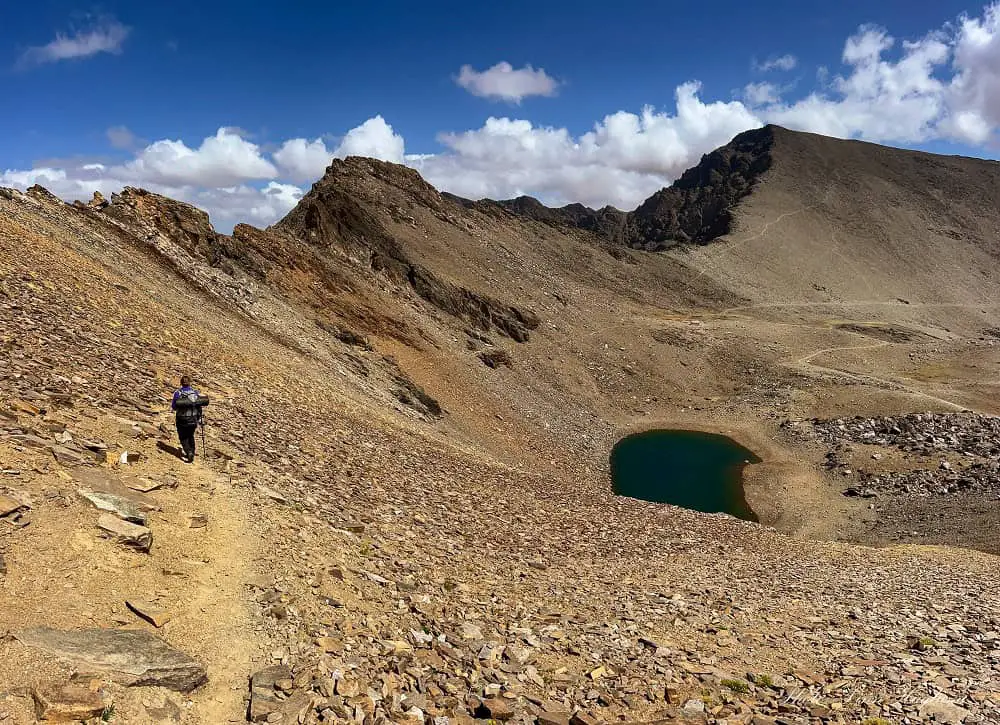
After a food break at Refugio de la Caldera, where we also filled up on water, we sweated our way up the most unforgiving slope of Mulhacén step by step.
Finally, on top of the Iberian Peninsula, we only had the time for a quick couple of photos and a snack before we had to walk fast-paced towards Siete Lagunas, where we wanted to camp.
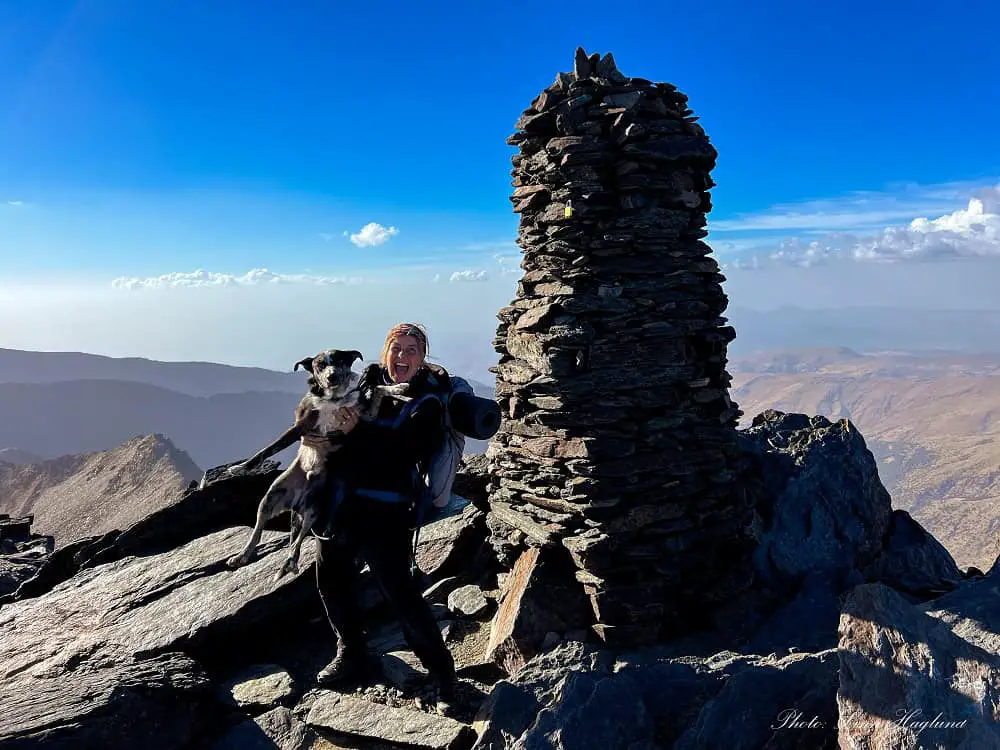
The weather had been on our side so far on the trek, but as the sun got lower, the wind picked up. Mohammed’s nose was so sunburned it started to bubble, and we realized we had forgotten sunscreen.
But that was the least of our worries.
By the time we reached Siete Lagunas, the sun was almost gone, and the wind was so aggressive that the tent almost flew away while pitching it.
We sheltered behind a big rock as protected as we could from the wind. Yet, the tent was flopping so hard we were worried it would rip.
Needless to say, we were exhausted, cold, and hungry. We cooked up a quick meal of couscous, hydrated soy, and veggies inside the tent while the dog was already snoring.
We didn’t take long to join him.

Day 3 – The scariest mountain pass of my life, hailstorm, fog, and rain
We somehow woke up on day three with renewed energy. Siete Lagunas is one of the most picturesque places in Sierra Navada with its green meadows, lakes, trickling water, and incredible views. Surrounded by unforgiving mountains.
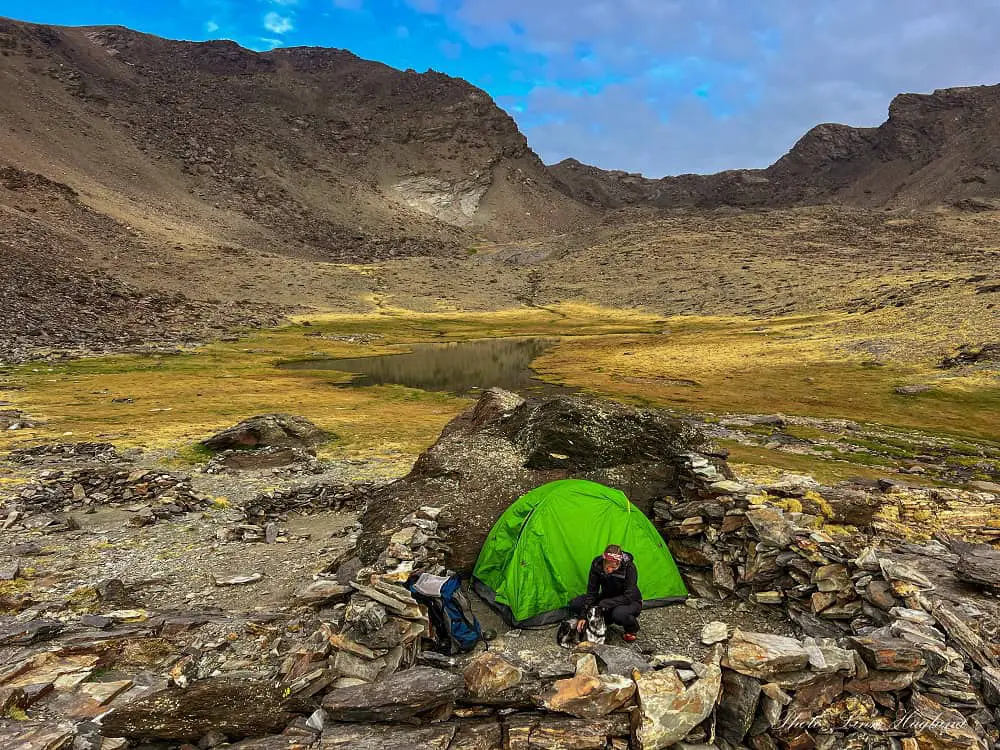
We had a lovely breakfast before filtering water to bring with us to the top of the Alcazaba.
I was so excited.
I had tried to reach this peak 2 times before, but the weather had put me back, and also the fact that I hadn’t found the peak.
And once I actually got lost and ended up walking a mountain goat trail to one of the most magical waterfalls I’ve encountered by mistake.
But that’s a different story.
We hadn’t walked for long before we lost the trail. Finding ourselves amidst large boulders and no trail, it started raining, and the wind picked up again. We tried to backtrack to find the trail. Then the hail started.
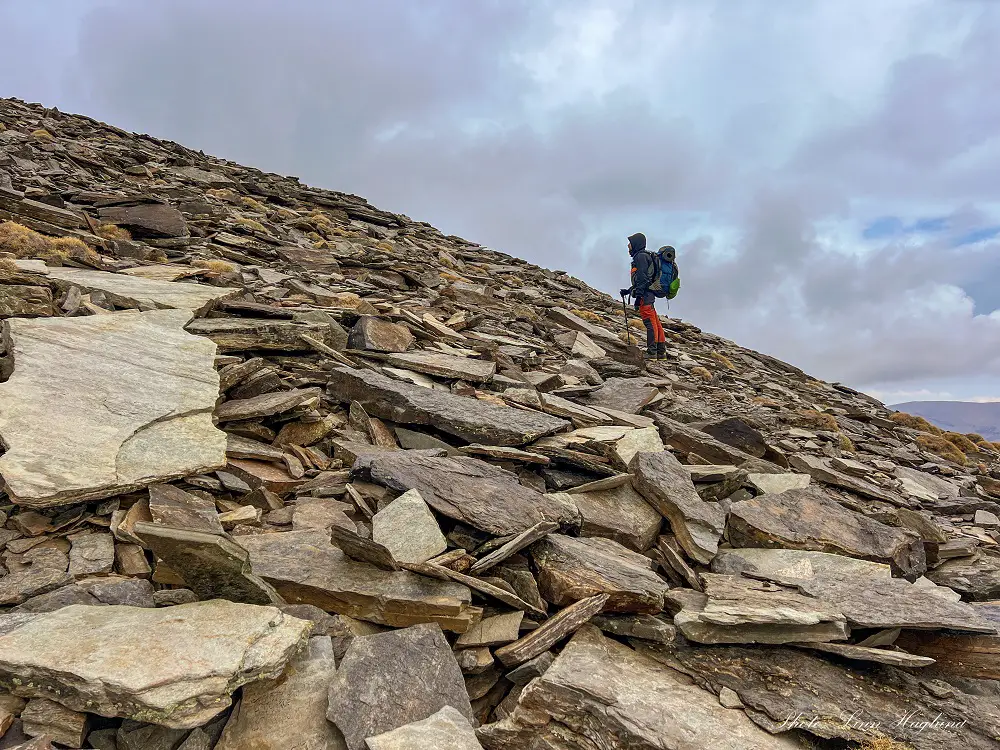
We were considering whether to continue or turn around at every step. Then the hail and rain stopped. The wind was still strong, but bearable. We kept walking.
The trail we found on Maps.me (remind me to never use that app again in the high sierra!) took us across another 3000-meter peak before getting to Alcazaba.
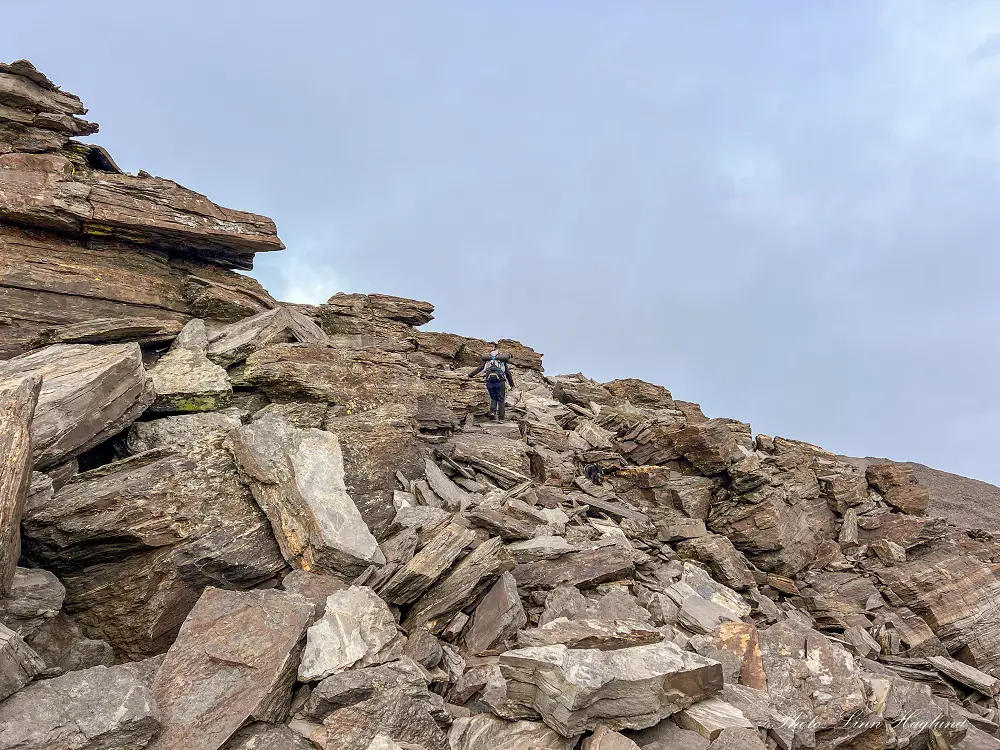
When we got closer to the top of this peak, it looked like a graveyard of boulders in front of us.
Looking back, I think there must have been a lightning strike that crushed the mountain in two, not long before, because the drops between the rocks that were just thrown around seemed to go straight down to the center of the earth.
It felt like the rage of Thor’s Hammer had been upon that mountain just hours before, and it made me feel so afraid of stepping wrongly and creating a rock slide. If I can compare that place to anywhere, it must be the road to Mordor.
We unleashed Atlas so that he could move more agilely without my fear transferring to him through the leash.
And I swear, my heart was not beating for way too many seconds until I saw him safely on the other side of this nightmare.
I tried walking a bit further to cross the mountain, but my vertigo started to play tricks with my brain, and the tears were pressing on.
We sat down and decided to walk down the side where we could see an easy trail that was probably going along the entire side of this insane mountain we had just crossed.
As I regained my strength and confidence, we decided on a route, and we were confident that the mountain in front of us was Alcazaba.

It was.
Alcazaba was even easy to walk up.
If it wasn’t for the dense fog that started to roll in, making our visibility near zero.
Again, we were discussing whether we should continue or turn around. But for every step, the fog – or clouds – opened up in front of us so we could continue.
We reached the Alcazaba, and we had no views due to the thick clouds that were surrounding us, but I was there.
Finally.
Third try.

On top of the Alcazaba, my phone ran out of battery. The phone had all the trail recordings and maps on it.
As we were filming a vlog with the other phone, we had to use the last bit of battery on the power bank to keep that phone alive until we reached the van on the last day.
On the way back, we took a different route. It was so steep that I had to sit down and slide with my hands holding on to rocks around me.
I can safely say that my vertigo got a good workout down that mountainside to Siete Lagunas. Yet, I would recommend going up that way (with hiking poles) instead of the route we took earlier that day.
We were so exhausted when we got down that we decided to pitch the tent in the exact same spot as the night before.
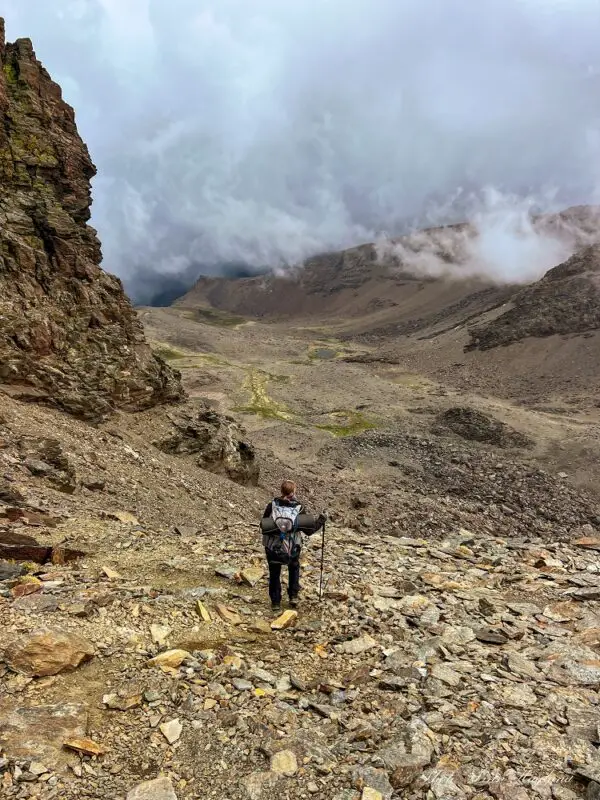
Oh, had we only thought of that before we headed up on that deadly walk to the Alcazaba.
Yet another lesson! We should have left our backpacks in a cave instead of carrying them up and down.
Many lessons learned from this day, but mainly: Check out the trail properly before heading out on a high mountain route I don’t already know.
Make sure I always have enough power banks with me (oh, I’m pretty sure I forgot to mention that we hadn’t charged them up properly before we left). But most importantly, I’m a lot stronger than I think I am.
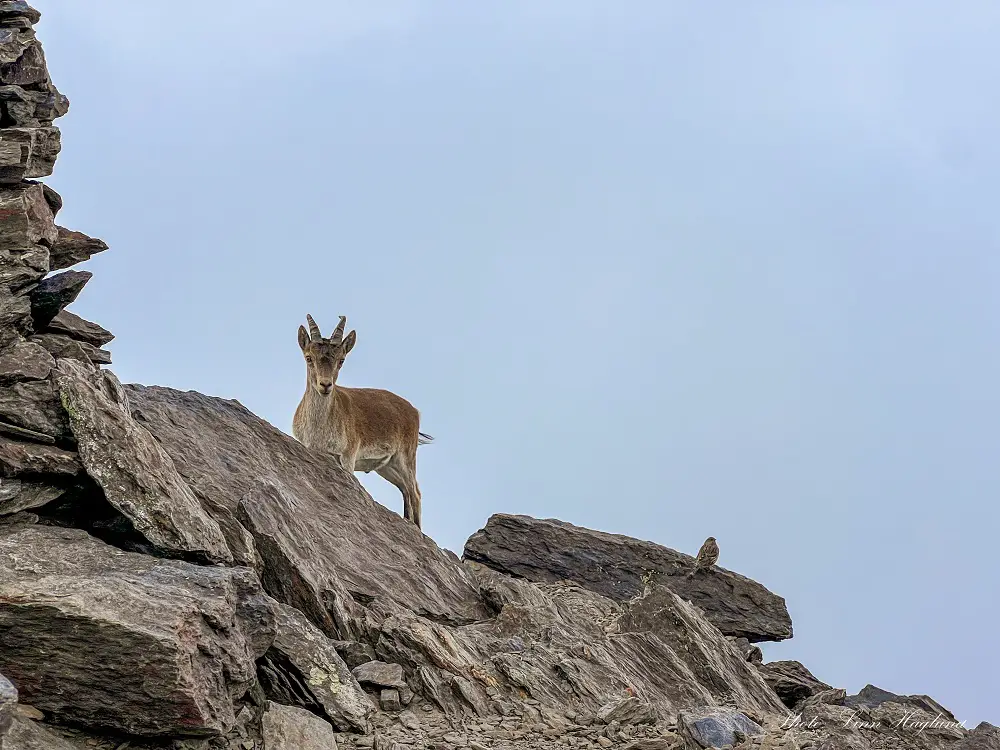
Day four – A long walk back to the van following my inner compass
The one reason I wasn’t too stressed about running out of battery on the phone that was guiding our way is that I’m pretty well hiked in this area of Sierra Nevada.
The only peak I didn’t know was Alcazaba. But because I had tried to hike it before, I knew pretty much everything around it (except for the actual trail up there – and I still don’t really know the exact way around that godforsaken peak that I can’t remember the name of. Let’s just call it Mordor.)
Therefore, I could easily navigate our way back to Hoya de la Mora without walking to the top of Mulhacén and Veleta, but instead walking around them.
While it was a lot easier and a lot flatter, we still had some hills to ascend and descend. We were tired and just wanted to get back to the van.
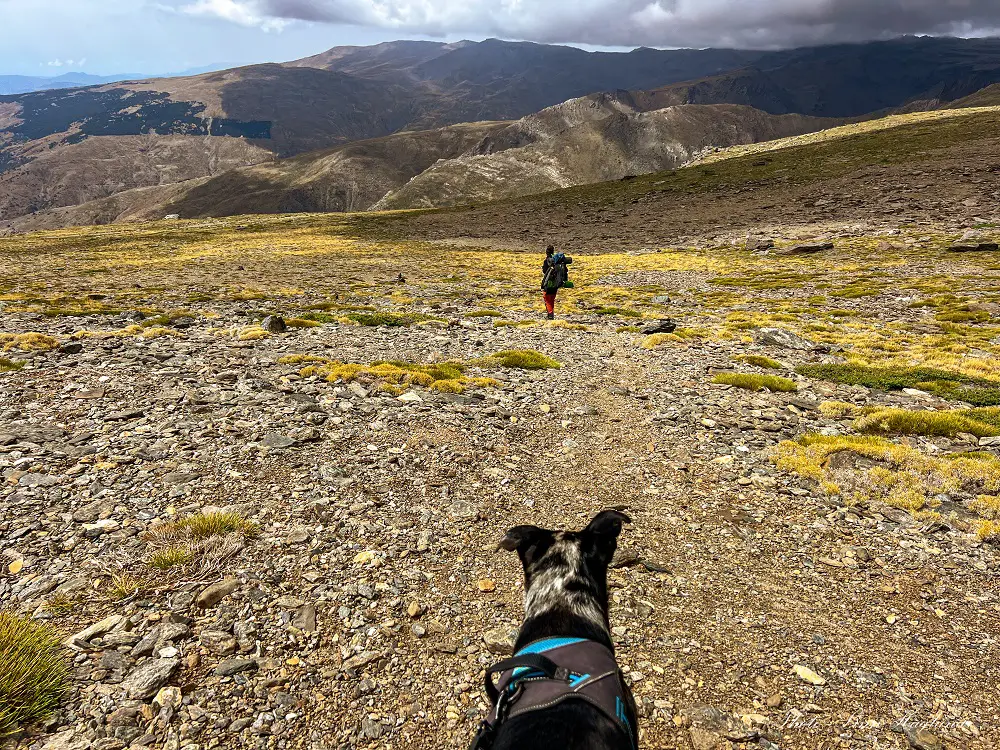
But the magic was not yet over. We met so many mountain goats on the way and had plenty of time to reflect on the incredible adventure we were on.
We made it.
We did climb the 3 highest peaks in Sierra Nevada National Park in 3 days, and the fourth day was just for walking back to the van.
And it did take us a day to walk back.
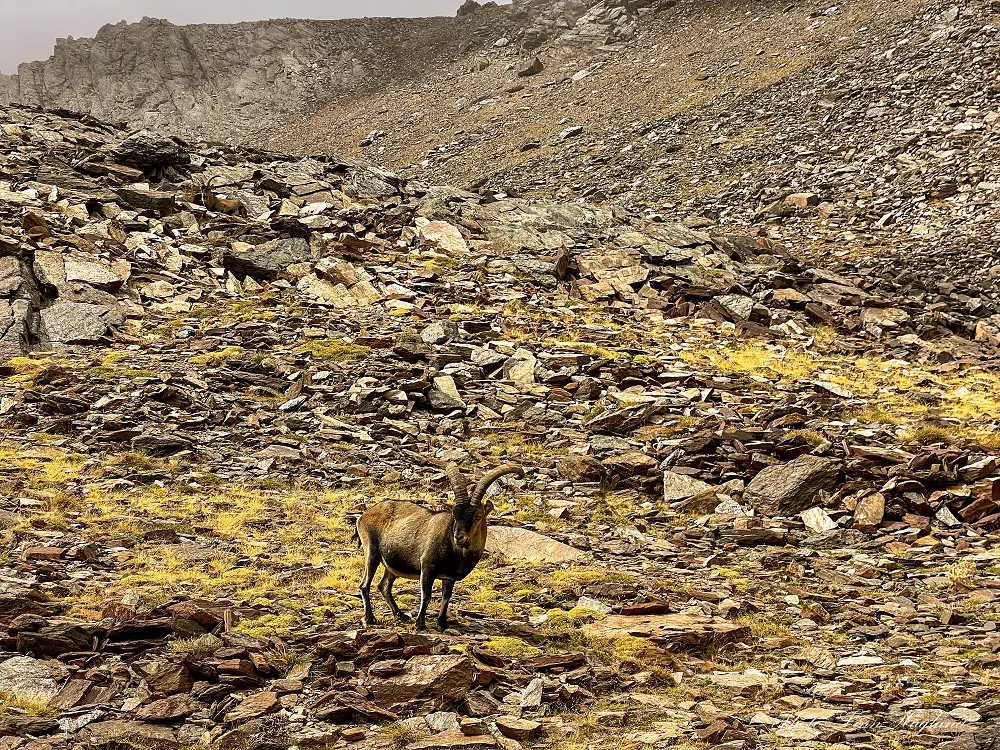
I’m glad we counted in an extra day. I wouldn’t have enjoyed it as much if we had had to hurry more than we already did. We definitely underestimated how hard the first day would be.
Of course, that’s when our packs were at their fullest with food for 5 days. Yes, I had packed for an extra day, just in case. And I would do that again.
You never know what can happen in the mountains, and if you get stuck for some reason, it’s better to have some extra fuel.

Reaching the van by sundown, we were completely exhausted, happy, and felt so accomplished.
Atlas was still jumping around, greeting hikers on the way with who-knows-what-energy, because he seemed like he had rested for the last two weeks and was ready for a new hike, he passed out the moment he found his soft pillow in his crate in the back of the van.
We drove straight down to the first pizza place, ordered takeaway, and stuffed our faces with pizza while watching a movie in the back of the van before we passed out!
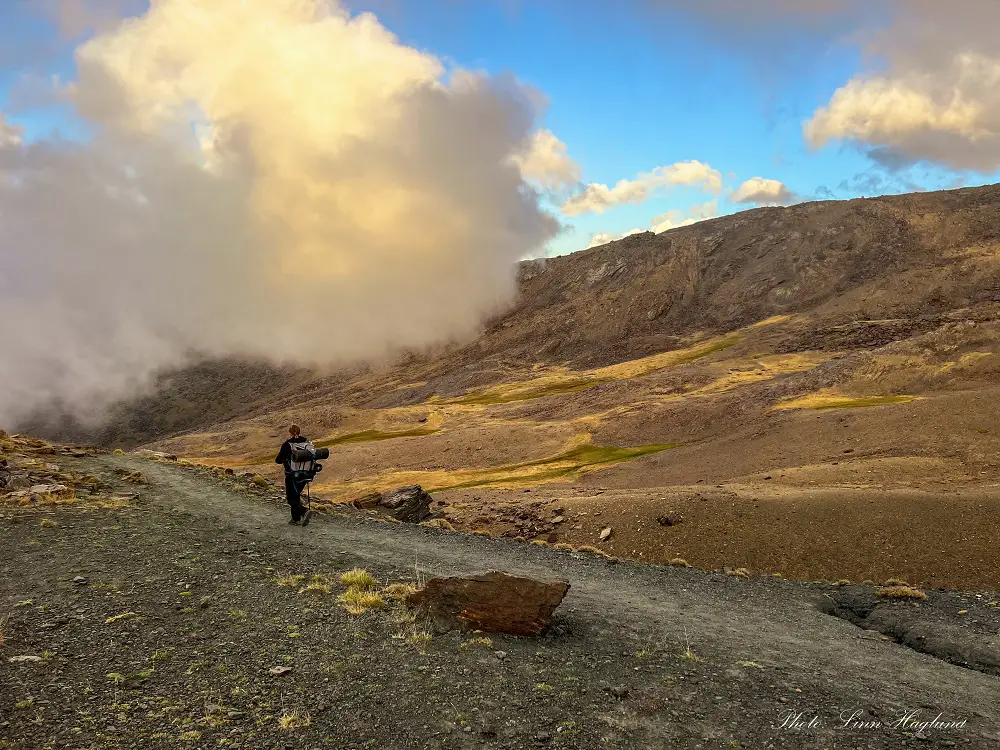
Summing up the lessons of this hike
While this was an amazing adventure and I’d do it all over again, there are some things I’d do differently.
I’ll sum up my main takeaways here:
- Make everything is packed the night before, even the fleece, we think we know where it is.
- Pack evenly and don’t take more than we can handle
- Bring more than one painkiller (we were lucky we only needed one!)
- Sunscreen!
- Set up the tent outside a fully packed refuge for a better sleep
- Plan the part of the route I don’t know a little better (download a route on Wikiloc and don’t trust Maps.me in the high sierra)
- Leave the backpacks at the bottom of a peak we’re gonna climb up and down the same spot
- Make sure I had enough powerbanks for both phones (as I said before, I was aware that they probably wouldn’t last the entire hike, I was also aware that I would navigate our way back to the van without a map in this case, but for any future route where I don’t know the area, this was a reminder of the importance of having some way of navigating

What I would do again:
- Bring food for an extra day
- Bring a water purifier – we used the Lifestraw squeeze bottle, which is lightweight and easy to use.
- Sleep in the van at the trailhead the night before the hike -this saved us the energy of driving and getting up even earlier
- Pack couscous and dried soy pieces in zipper bags bc it’s full of energy and super lightweight
I hope you got something out of our little adventure, whether you’re a seasoned hiker who finds our hike a walk in the park, or if you’re less experienced.
Either way, happy hiking!
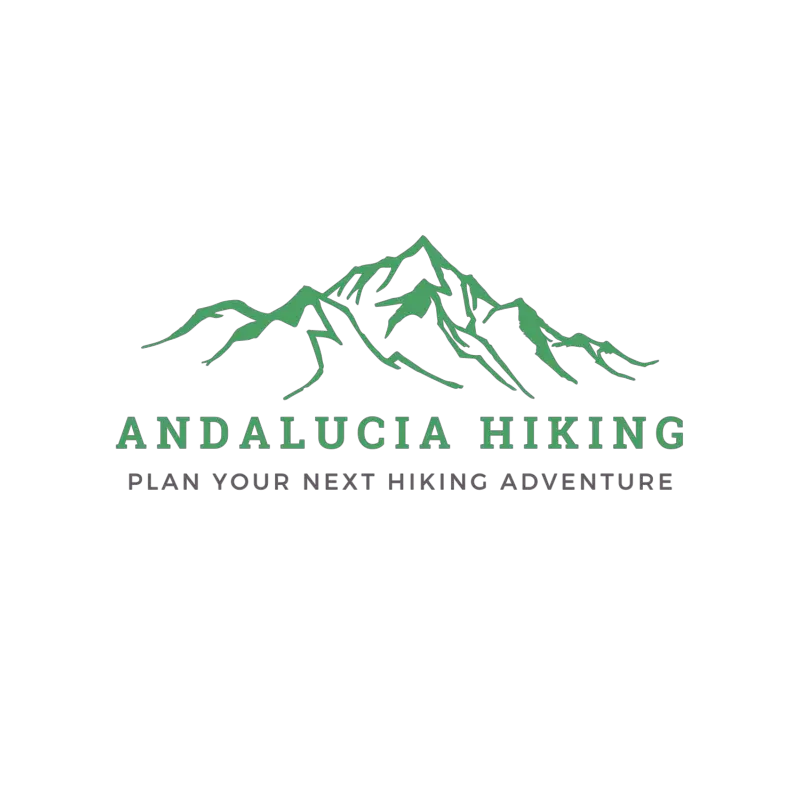

Hi Linn I have read about your solohiking in Sierra Nevada before and I am impresed with what you and your soulmate have done. I also know that you always can learn new things on every hike. Safety is always the first roul and the wheather can change in a minute op there. Have a good Journey
Thank you! The mountains is definitely our happy place, but you always gotta respect the elements:)